Azulejos is the feature that strikes every tourist in Portugal, the beautiful ceramics that colour many buildings from north to south in white and blue. A trip to Portugal in search of azulejos is like visiting a huge open-air museum. From the spectacular São Bento station in Porto to the thrilling azulejos panel at the entrance to the town of Óbidos, via Maria Keil’s contemporary reinterpretations in the Lisbon metro, Portugal is the perfect destination if you love painted tiles.
Table of Contents
What are azulejos
Azulejos are the glazed ceramic tiles, traditionally square and coloured white and blue, that decorate the façades of many public and private buildings in Portugal. The tiles are a typical element of Portuguese architecture and derive from the Spanish alicatado, brought by the Arabs to the Iberian Peninsula.
The term azulejo itself derives from the Arabic word az-zulaiŷ meaning ‘polished stone’. Because of its history, you can also discover ceramic decorations in Morocco and other areas historically dominated by the Arabs. Only in Portugal, however, have azulejos become an iconic and distinctive element of local architecture.
The best known Portuguese azulejos are in fact the white and blue Baroque-era azulejos that decorate walls, floors and ceilings of public buildings, churches and palaces. To learn more about their history you can visit the National Azulejo Museum in Lisbon, housed in the cloister of the former convent Madre de Deus.
Currently, Portugal continues to produce hand-painted azulejos through traditional methods, making them delightful souvenirs to bring back. Additionally, you can appreciate industrially crafted ceramics inspired by contemporary art, seen in places like metro stations.
Azulejos and cultural blend
Portuguese azulejos, like many innovations, emerged as a cost-effective solution to overcome challenges. The imported alicatado technique from the Arabs, showcased at the Alhambra in Granada, proved to be an expensive and intricate process. Decorating with glazed clay slabs required specialized masters skilled in manual cutting.
To make ceramic decoration more versatile, the technique underwent modification, producing smaller clay slabs using square-shaped moulds. The trend began at the Palácio Nacional in Sintra, marking the inception of azulejo decoration in Portuguese palaces. Over time, azulejos integrated seamlessly into Portuguese architecture, featuring geometric motifs and real paintings.
What fascinates me about azulejos is their cultural amalgamation. The iconic blue and white tiles depicting painted scenes, synonymous with Portugal, are a fusion of Moorish style and Italian majolica. While the Arabs adorned their palace facades with tiles featuring traditional geometric motifs, in Italy, particularly in Faenza, a pictorial decoration trend was evolving. In the 16th century, Italian artists Francisco Niculoso ‘Pisano’ and Guido di Savino brought their techniques to the Iberian Peninsula via Flanders, which was then under the Spanish crown.
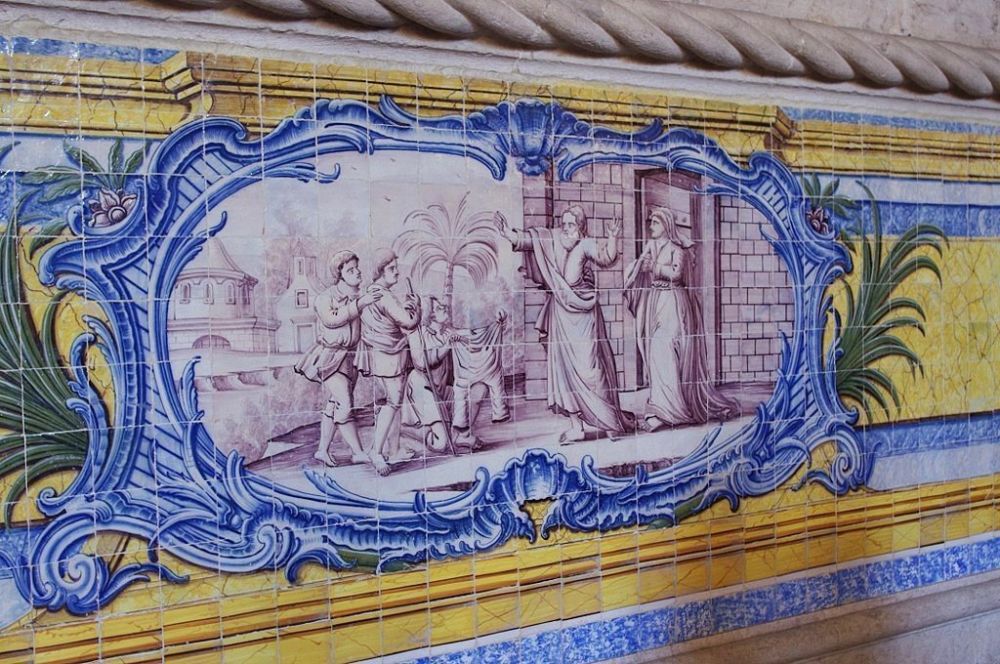
Where to find azulejos in Portugal
Once captivated by the intriguing history of azulejos, the anticipation to witness them in person is undeniable. In Portugal, the options abound, particularly in major cities like Lisbon and Porto. Below are addresses highlighting some of the most iconic azulejos. However, embarking on a road trip across the country opens up the possibility of uncovering these exquisite tiles in even the most hidden corners.
Lisbon tiles
The best way to start your azulejos-hunting trip is in Lisbon, the capital of Portugal. Apart from seeing the glazed ceramics, Lisbon is a city to visit for so many reasons, starting with the historic yellow tram and the excellent food. To discover it, I recommend buying the Lisbon Card because it includes access to museums, including the Museu Nacional do Azulejo, as well as public transport.
Public buildings with tiles in Lisbon
- Monastery of São Vicente de Fora, Largo de São Vicente
in addition to azulejos depicting historical scenes, you can enjoy panoramic views of Lisbon - Monastero dos Jerónimos, Praça do Império
UNESCO heritage site, includes some beautiful azulejo decorations - Museu Nacional do Azulejo, R. Me. Deus 4
museum housed in a 16th century monastery with a richly decorated chapel - Fundação das Casas Fronteira e Alorna, Largo São Domingos de Benfica 01
the façade is decorated with azulejos and you can also stroll through the delightful Italian-style gardens - Casa do Ferreira das Tabuletas, Rua da Trindade 32
museum of local history with a beautiful façade decorated with azulejos
Tiles factories in Lisbon
- Fábrica Viúva Lamego, Largo do Intendente Pina Manique
the façade is decorated with Asian plants and vegetables to recall the trade between the Orient and Portugal - Fábrica Sant’Anna, Calçada Boa Hora 96
founded in 1741, still continues to produce azulejo using artisanal methods
Exploring azulejos: additional places and addresses in Lisbon
Miradouro de Santa Luzia, Largo Santa Luzia
vantage point decorated with azulejos from which to admire Lisbon from above
Largo Rafael Bordalo Pinheiro, 28-34
building covered in yellow and blue azulejos, with symbolic figures representing land, water, commerce, agriculture, industry and science
- Rua das Janelas Verdes, 70-78
palace with yellow decorations inspired by Art Nouveau, near the Museu Nacional de Arte Antigua - Rua de São Domingos à Lapa, 43-45
small building that is difficult to find because it is overlooked by a newly constructed building. The façade is covered with azulejo with botanical subjects - Rua do Milagre de Santo António, 14
palace visible from São Jorge Castle in Lisbon, with azulejo with a religious subject on the miracle of the loaves and fishes, and water turned into wine - Campo de Santa Clara, 124-125-126
Baroque decoration in yellow and blue with drawings of half-busts - Rua do Sacramento à Lapa, 24
Portuguese Romantic period palace with azulejo-covered windows in Baroque and Art Nouveau style - Rua do Possolo, 76
palace housing the embassies of Finland and the Azores, covered in blue azulejo - Rua das Cruzes da Sé, 13-15
former scales factory near Lisbon Cathedral. The 1918 decorations in white and blue refer to the theme of ‘weight’ in honour of the production within it
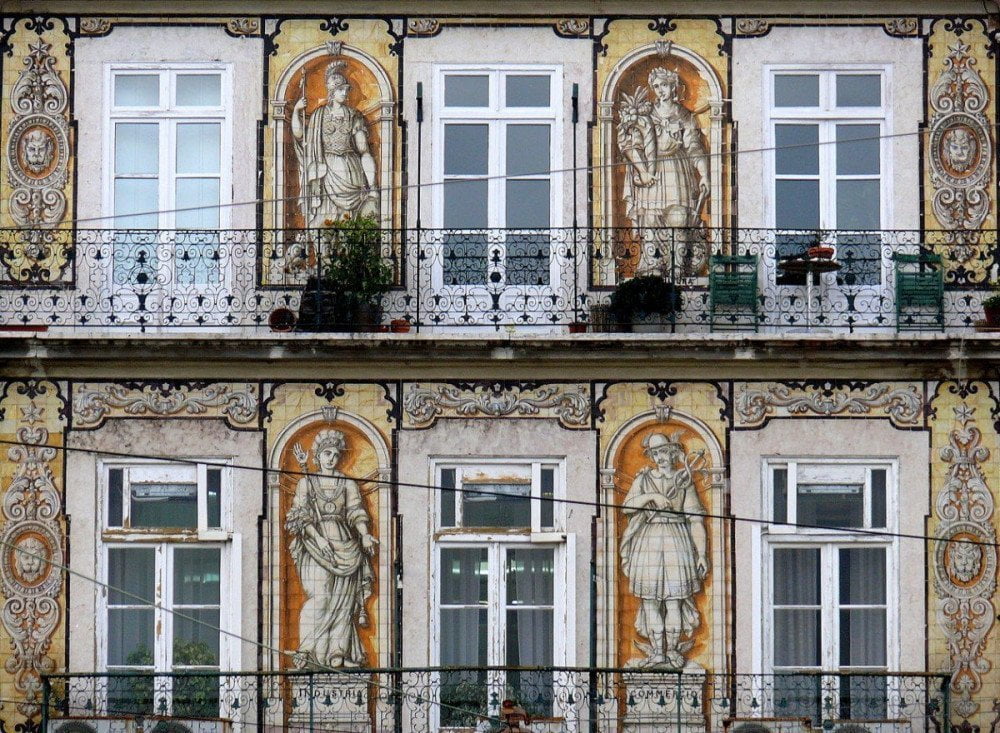
Porto azulejos
Porto is the city with the most buildings covered in tiles, a veritable open-air museum full of iconic places. For Porto, it would be impossible to list streets and squares where you can admire the ceramic decorations as I did for Lisbon because they are literally everywhere, you just have to lift your head to see azulejos!
Especially the historic district of Ribeira is full of buildings with such beautiful façades that they will leave you breathless. In the same neighbourhood you can also admire the Ribeira Negra, a huge azulejo mural created by Portuguese painter Júlio Resende in 1987.
As in Lisbon, I suggest you buy the Porto Card before you leave to discover all the city’s attractions and save on entrance fees and transport.
Porto’s São Bento Station
My introduction to Porto began with the awe-inspiring atrium of São Bento Station. Specifically arriving by train to purposely indulge my curiosity in these iconic azulejos. The neoclassical building’s atrium is adorned with around 20,000 blue and white tiles crafted by Jorge Colaço. These tiles feature motifs depicting historical battles and scenes from Portuguese life. For those intrigued by historical mysteries, rumors abound of the ghost of the last nun from the convent that once occupied this site before the station.
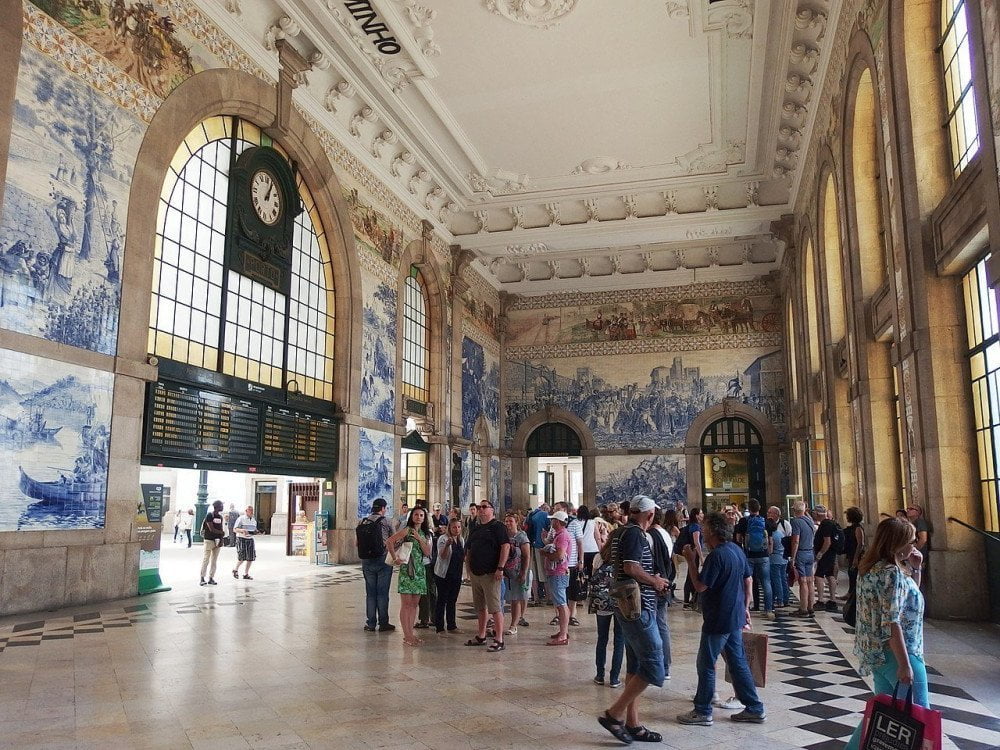
Churches decorated with tiles in Porto
- Porto Cathedral, Terreiro da Sé
the south side of the cloister is decorated with blue azulejo by the artist Antonio Vital Rifarto - Igreja do Carmo, R. do Carmo
this church is one of the most representative Rococo buildings in Porto - Igreja de Santa Clara, Largo Primeiro de Dezembro
is considered the Baroque jewel of Porto - Capela Das Almas, Rua de Santa Catarina
built in the 17th century and decorated with blue azulejo only in 1929. The decoration depicts scenes from the lives of Saint Catherine and Saint Francis of Assisi, painted by the artist Eduardo Leite - Igreja de Santo Ildefonso, R. de Santo Ildefonso
the spectacular façade of this church is decorated with some 10,000 azulejos painted by Jorge Colaço, the same artist as the São Bento Station, and depicts the life of St. Ildefonso together with allegorical scenes of the Eucharist.
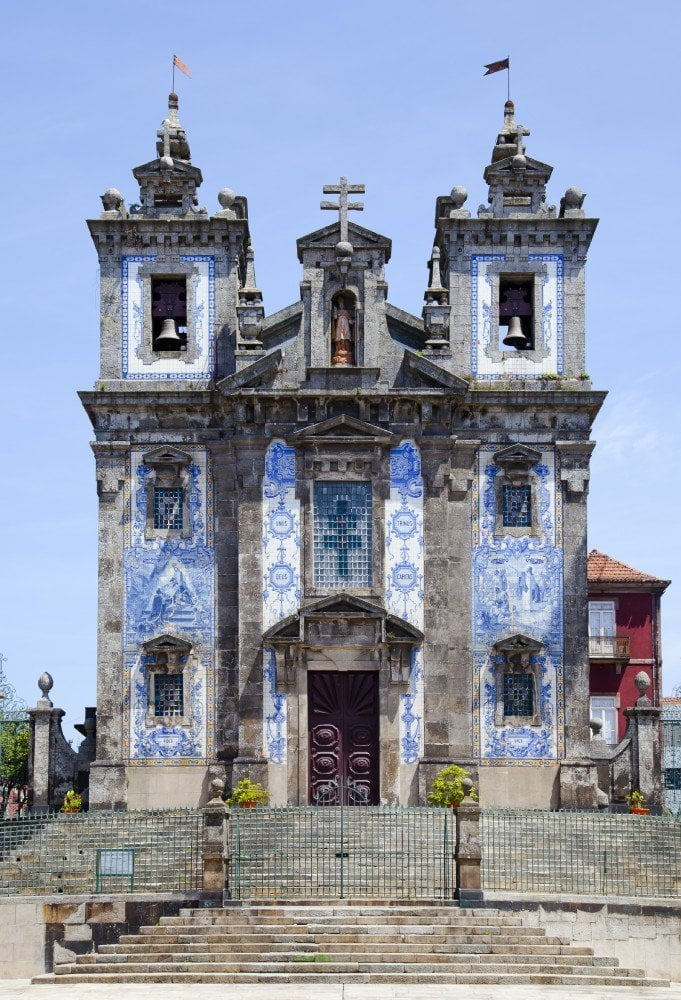
More locations across Portugal to discover azulejos
If you are planning a road trip through Portugal and want to add unique azulejos to your list, I suggest you also visit Sintra and Obido. These two locations are also easily accessible with organised tours from Lisbon if you don’t want to rent a car.
Sintra
Sintra is often referred to as the Versailles of Portugal, a nod to the opulent Palácio Nacional de Queluz, a magnificent royal residence located there. To visit it, remember to book your skip-the-line tickets for the National Palace and Queluz Gardens in advance.
To see the ceramics, however, you have to go to the other Palácio Nacional in Sintra and don’t worry about the name thing, even it took me a good 15 minutes to realise that both buildings were a Palácio Nacional and both were in Sintra.
The Palácio Nacional de Sintra, also known as the Palácio da Vila, is the perfect place to marvel at tiles. It’s a blend of various architectural styles, including medieval, gothic, Manueline, renaissance, and romantic elements seamlessly woven together. Despite this eclectic mix, the overall effect is not overwhelming, and this palace boasts the largest collection of azulejos in all of Portugal.
Obido
Obido is a small town not far from Lisbon, surrounded by characteristic fortified walls. In your search for azulejos, remember to stop in front of its main entrance to admire the chapel decorated with tiles telling religious stories.
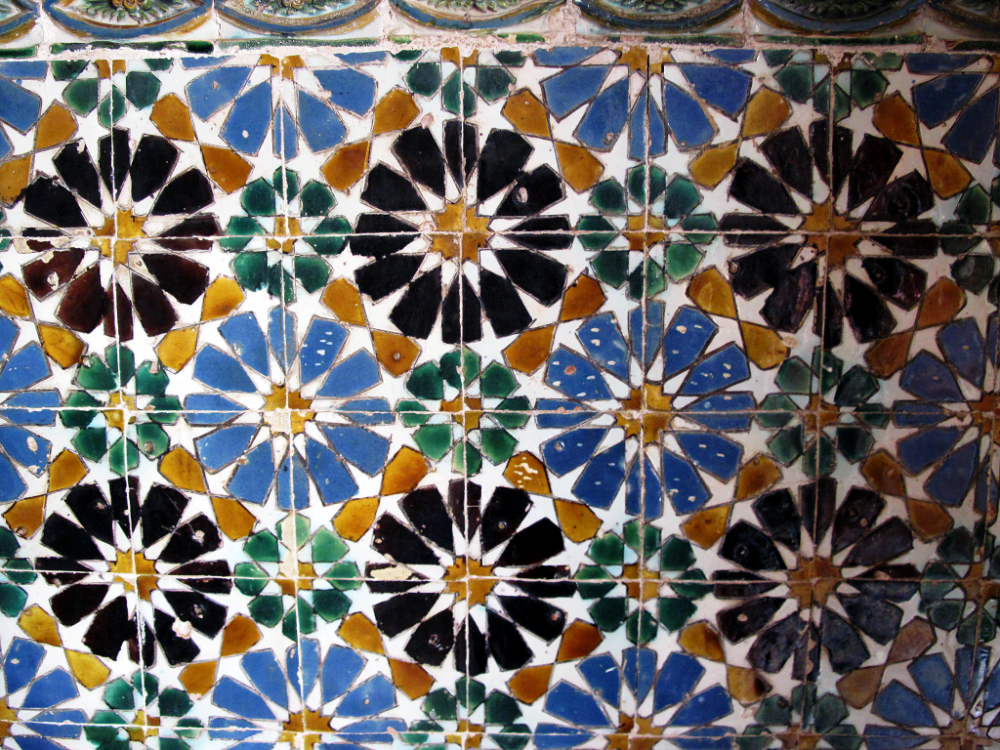
Portuguese azulejos and contemporary art
While azulejos adorn many of Portugal’s historic sites, they haven’t remained confined to religious representations or ancient architecture. Numerous contemporary artists have embraced and adapted their techniques, presenting them in a modern context.
Renowned figures like Maria Keil, who embellished Lisbon’s metro, and Júlio Resende, the creator of Porto’s Ribeira Negra mural, have left their mark on the evolution of this decorative language. Architect Raúl Lino, between 1907 and 1915, reimagined azulejos with abstract motifs and stylized references to natural forms.
During the periods of military dictatorship and Salazar’s rule, the art of azulejos experienced a lull, only to resurge in the 1950s. In this renewed era of azulejo, the façades of the Hotel Ritz in Lisbon and the Palace of Justice underwent intricate tile coverings.
This resurgence continued with the construction of the Lisbon Metro and the Via Sacra in the Fátima Sanctuary. The contemporary style of azulejos also embraced an optical approach, evident in the works of Eduardo Nery and João Abel Manta.
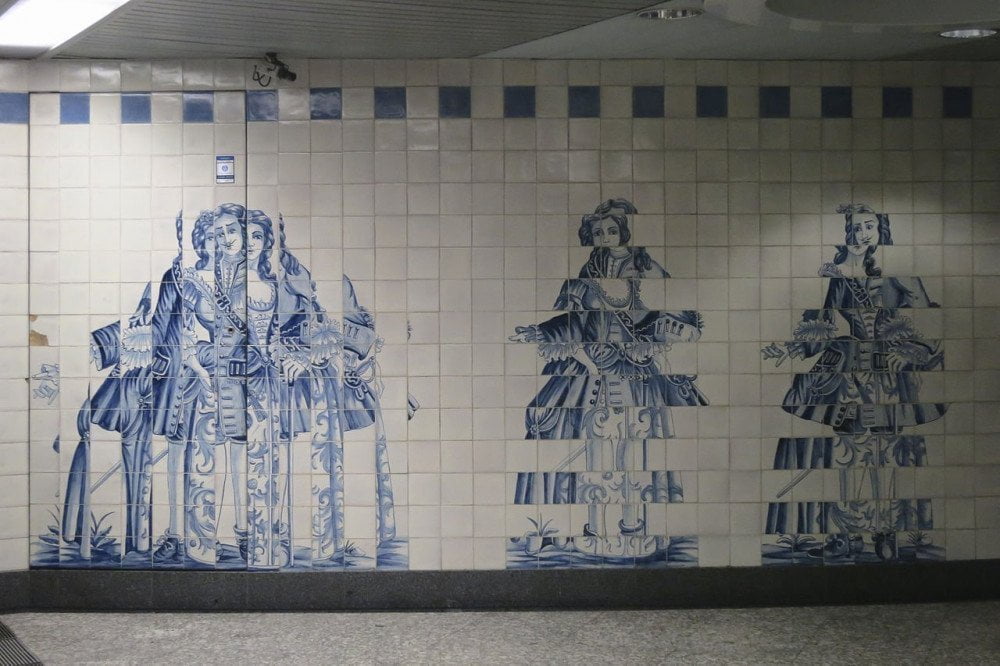
Portugal is famous for its historical and modern azulejos, a must-see during a visit to this country. From ceramic tiles to real works of art, azulejos accompany you in every city and town, from Lisbon to Porto. Tell me in the comments which of these buildings and works of art you have already seen live, or if this article has inspired you to choose Portugal as your next destination.
